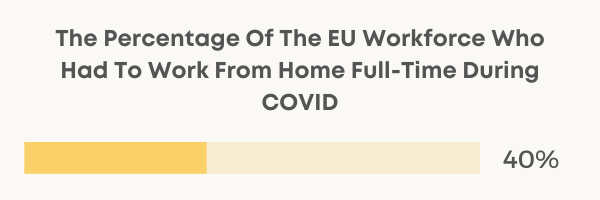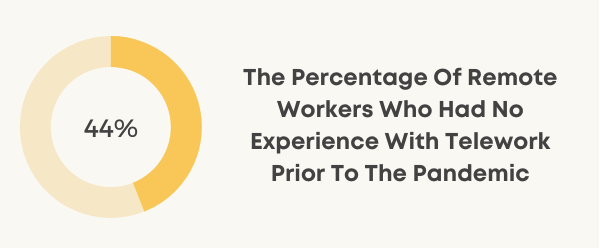Like the rest of the world, Europe also went into lockdown with the outbreak of the Coronavirus pandemic.
So, how many people had to quit their office and start working from home in Europe?
Which European regions were leaders in remote work and which had fewer people working from home?
If you continue reading this article, you will find out about the most interesting remote work Europe statistics!
Editor’s Pick Of Remote Work Statistics For Europe
- Regions in Finland and Belgium report the most remote workers.
- 40% of the EU workforce started working from home during COVID.
- 78% of European workers say they prefer remote work.
- Out of all remote workers, 46% did not have prior experience with it.
- Out of remote workers, 24% admit working in their free time.
16 Remote Work Europe Statistics
1. 12% of EU workers (aged 20 to 64 years) usually worked from home in 2020.
Before the pandemic, the number of those working from home in the European Union (EU) remained at five to six percent for the last decade. However, since the pandemic, that number has gone up to 12%.
Source: EU Labor Force Survey
2. Three EU regions with the highest share of remote workers were Helsinki-Uusimaa (37%), Province du Brabant wallon (27%), and Région de Bruxelles-Capitale (26%).
Besides those three EU regions, some regions in Ireland (25%), Austria (24%), Denmark (24%), France (23%), Netherlands (23%), and Portugal (23%) also had a high number of people working from home.
Source: EU Labor Force Survey
3. Remote work was less common in eastern and southern regions of the EU, with less than 5% of the workforce working from home in some of those countries.
Out of those regions, Croatia, Cyprus, Bulgaria, and even Latvia had only 5% of the workforce working from home. The list of those with 5% of remote workers also includes Hungary, Romania, and Greece.
Source: EU Labor Force Survey
4. Around 40% of the EU workforce had to start working from home full-time as a result of COVID-19.
Around 4 in 10 workers started teleworking once the pandemic was announced. Moreover, according to remote work Europe statistics data, around 25% of all jobs in the EU are teleworkable.
Source: Eurofound


5. Out of those working from home at least sometimes, the number rose from 5.2% in 2009 to 9% in 2019.
Before the pandemic started in 2020, remote work was slowly increasing in the decade before it, rising from 5.2% to 9% in the EU.
Source: Eurostat
6. 30% of those self-employed worked from home sometimes or usually in 2009, rising to 36% in 2019.
Out of those who worked from home prior to the pandemic, self-employed people were more common to work remotely than dependant workers.
Source: Eurostat
7. One in four (25%) of those in the top quarter of EU-27 income distribution worked from home in 2018, compared to 10% of those in the bottom half of the income distribution.
As more of those who have a higher income have been working from home in the EU, the access to remote work only adds to the income inequality in the 27 Member States of the European Union.
Source: Eurostat
8. Sweden, Finland, and the Netherlands were among countries that had a share of remote workers of around 30% in 2019.
While those northern countries had a higher percentage of those working from home, in half of EU Member States the number of teleworkers was below 10% in 2019.
Source: European Commission
9. There could be 4,3 million fewer jobs in food and customer service, as a result of higher-paid jobs becoming remote over the next decade.
In Europe, the highest-paid jobs are the most possible to be done remotely, and the lowest-paid ones are the least possible. That is why low-skilled and low-paid jobs will be at risk, such as food preparation, office cleaning, etc. However, jobs in delivery and transportation should increase by 760,000.
Source: McKinsey
10. While 48% of the EU workforce worked remotely at least part-time, one in three (34%) of them were exclusively working from home.
Compared to low numbers pre-pandemic, work from home became much more popular across the EU once the global pandemic started. This has also led to a higher number of those feeling remote working burnout.
Source: Eurofound
11. 78% of workers admit they prefer remote work at least to some extent even if there were no pandemics or restrictions.
Remote work is a growing trend and flexibility is one of the biggest work perks that employees want. Moreover, almost eight in 10 workers say they would like to work remotely at least to some extent if there were no pandemics, as well. Almost one in three (32%) would like to work from home several times a week, and 13% would like to work remotely full-time.
Source: Eurofound
12. 54% of those who worked from home during the pandemic had experience with work from home from before, 46% didn’t.
Almost half of the workers (46%) who were sent home from offices to work during the pandemic were completely new to remote work.
Source: Eurofound


13. 24% of those who worked from home report working during free time, compared to 6% of those who work on-site or locations away from home.
When working from home, employees have a harder time switching off. As both the personal and professional life is happening in their home, it is harder for them to set boundaries, so they end up working in their free time, as well. This can lead to workers’ burnout.
Source: Eurofound
14. In the United Kingdom and France, 47% of the workforce worked from home in 2020.
Compared to a year before, the percentage of those working from home in the UK rose by 20% in 2020. Similarly, compared to 2019, the percentage of remote workers rose by 25% in France in 2020. Furthermore, in Italy remote work increased by 15% compared to the year before.
Source: OECD
15. The trend of remote work was higher in large firms in the UK and France, compared to smaller businesses.
This makes sense as more teleworkable sectors make up larger firms in those two countries, while smaller businesses in the UK and France mostly make up jobs that are not teleworkable. According to OECD data, this also shows that larger firms have access to more technology that allows them to do work remotely.
Source: OECD
16. 33% of the UK workforce documented an increase in productivity during remote work in lockdown.
While 71% of companies in the UK saw no significant impact of working from home on productivity, one in three reported an increase in productivity when working from home.
Source: CIPD
Final Verdict
To sum up, these remote work Europe statistics include statistics from all over the European Union, but also the countries who are not the Member States, such as the UK. While remote work did exist pre-pandemic in Europe, the numbers significantly rose since the start of the pandemic. After all, remote work statistics are telling us that this type of work will continue to grow in the future, too.


































Find Us on Socials